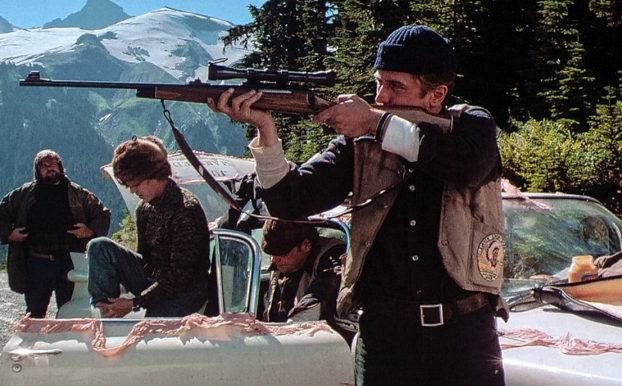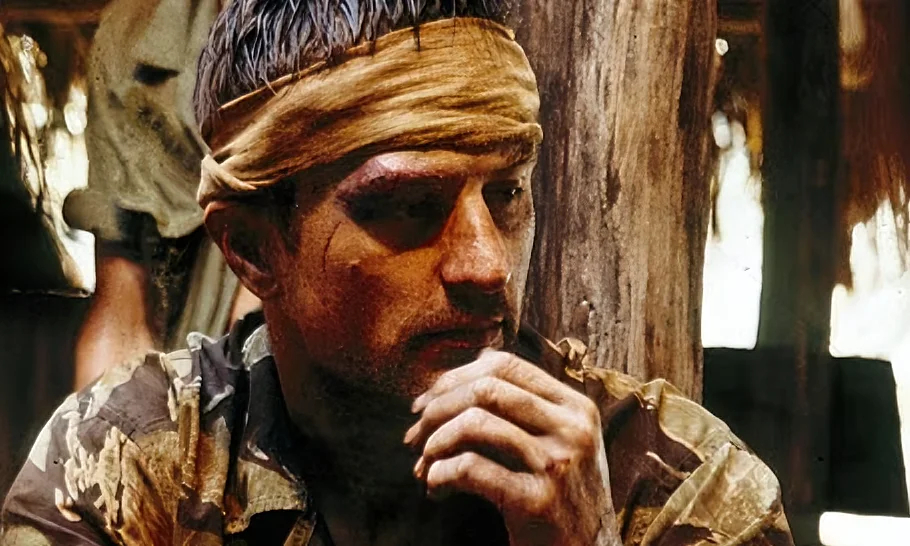The Deer Hunter (1978)
Few films capture the brutality and psychological toll of war quite like The Deer Hunter. Directed by Michael Cimino, this 1978 war drama offers a profound exploration of friendship, loss, and the struggle to reclaim one’s identity after experiencing unimaginable trauma. With a stellar cast including Robert De Niro, Christopher Walken, John Savage, Meryl Streep, and John Cazale, the film tells the story of three men whose lives are forever changed by the Vietnam War.
Structured into three distinct acts—before the war, during the war, and after—the film highlights the devastating effects of combat, particularly psychological suffering and loss, setting a new benchmark for war films.
Now, let’s dive into its storyline, themes, characters, cinematography, and lasting impact.
1. The Bond Before the War – Clairton and Brotherhood
The film opens in Clairton, Pennsylvania, a tight-knit working-class town where steel mill workers Mike (Robert De Niro), Nick (Christopher Walken), and Steven (John Savage) share a strong brotherhood. Their daily lives revolve around work, friendship, and ritualistic deer hunting, reinforcing their belief in control, skill, and honor.
Key moments:
- Steven’s wedding – A joyous event that contrasts the impending horrors of war.
- The bar scene – Singing Can’t Take My Eyes Off You, symbolizing carefree youth before their lives are shattered.
- Deer hunting tradition – Mike insists on killing the deer with a single shot, reflecting his belief in precision and control, which will later be tested in Vietnam.
This section sets the stage for their camaraderie, making their eventual trauma all the more devastating.
2. Vietnam – Chaos, Captivity, and Russian Roulette
The second act brutally transitions from the safety of home to the nightmare of war. After an abrupt cut from Clairton, we see Mike, Nick, and Steven captured by Viet Cong soldiers—forced into a horrific game of Russian roulette.

Key moments:
- The Russian roulette sequence – A tense and visceral metaphor for the unpredictable nature of war. The random pull of the trigger mirrors how soldiers are thrust into life-and-death situations beyond their control.
- Mike’s leadership – He maintains mental fortitude, understanding that emotional weakness will get them killed. His ability to outthink the captors allows them to attempt an escape.
- Nick’s psychological breakdown – Already deeply shaken, Nick succumbs to a fatalistic mindset, unable to break free from the trauma.
Here, the film shifts from physical survival to psychological disintegration, setting up the emotional devastation of the final act.
3. The Aftermath – Survivors vs. the Lost
Returning home, Mike struggles to reconnect with a world that no longer feels real. His experience in Vietnam has fundamentally changed him, making even small pleasures seem hollow.
Key moments:
- Steven’s suffering – Permanently disabled, confined to a veteran’s hospital, he embodies the war’s lasting consequences.
- Mike and Linda (Meryl Streep) – A possible romance exists, but emotional scars prevent true connection.
- Nick in Saigon – Lost in a world of underground Russian roulette gambling, his fate is sealed—war has consumed him completely.

This section presents the tragic contrast between those who return home and those who never truly escape, illustrating the psychological toll of war.
4. Themes – The Psychological Toll of War
The Deer Hunter goes beyond battle sequences to explore the emotional and mental collapse of its characters. Key themes include:
- Survivor’s guilt – Mike grapples with why he survived while others didn’t.
- The randomness of fate – Russian roulette symbolizes the cruel unpredictability of war.
- Loss of identity – Nick is physically alive but mentally lost, showing how some soldiers never fully return.
Rather than glorifying war, the film shows how it destroys more than just bodies—it destroys minds, relationships, and futures.
5. Cinematic Techniques – Contrast Between Home and War
Michael Cimino uses visual storytelling to contrast peace and chaos:
🎥 Lighting and Atmosphere
- Clairton’s warm glow vs. Vietnam’s harsh, chaotic tones, emphasizing innocence lost.
- The hunting sequences mirror war scenes, shifting from calm precision to desperate survival.
🔊 Use of Sound and Silence
- The eerie silence before pulling the trigger in Russian roulette builds unbearable tension.
- Emotional moments are often subdued, making pain feel more realistic and haunting.

These techniques create immersion and emotional depth, making the film feel less like a typical war movie and more like a psychological case study.
6. Legacy – Why The Deer Hunter Still Resonates
🏆 Academy Awards – Five Oscars, including Best Picture, Best Director, and Best Supporting Actor (Christopher Walken). 🎬 Influence on War Films – Inspired films like Saving Private Ryan and The Hurt Locker, which also prioritize psychological trauma over action spectacle. 📜 Cultural Significance – Preserved by the National Film Registry as a film of historical and artistic importance.
Unlike traditional war films, The Deer Hunter makes us feel the weight of loss, fear, and unspoken pain, ensuring it remains a masterpiece of war cinema.
Final Thoughts
The Deer Hunter is not just a war film—it is an exploration of human endurance, trauma, and irreversible change. Whether examining its symbolism, performances, or cinematography, it remains one of the most emotionally powerful films ever made.
